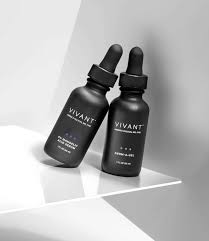
Can I Use Mandelic Acid and Retinol at The Same Time?
There are some existing blog posts that focus on the best way of layering active ingredients to achieve your skin goals. However, there are some potent powerhouses that should be avoided to prevent the risk of irritation and negative side effects.
Yes, the truth is you can have too much of a good thing, so with that in mind, we will be drawing attention to how both ingredients work on the skin and answer the question, can you use mandelic acid and retinol at the same time?
What is Mandelic acid?
Derived from bitter almonds, mandelic acid is a chemical exfoliant and is a member of the AHA family.
Known as one of the gentlest exfoliants, those with sensitive skin can use mandelic acid due to its larger molecular size preventing it from penetrating too far into the skin, causing irritation.
Proven to have visibly reduce the appearance of hyperpigmentation, melasma, dark spots, sun damage, and other areas of uneven skin tone.
Can help manage acne flare-ups, unclog pores, dissolve blackheads, and regulate sebum production.
By ridding the skin of dead skin cell build-up, mandelic acid can reduce the appearance of fine lines and wrinkles. The skin appears firmer with more elasticity.
Is very compatible with other ingredients when used correctly in your existing skincare routine (more on this later)
Find out more about mandelic acid on our dedicated blog post.
What is Retinol?
A potent form of vitamin A with a variety of derivatives formulated into a few different products, from prescription strength to over the counter.
Increases the speed of the natural skin cell turnover, sloughing away dead skin cells and revealing a brighter, younger, glowing complexion.
Has a smaller molecular size meaning it can reach further down past the epidermis (the outer surface of the skin) and into the dermis.
Helps to boost the production of collagen and elastin creating a plumper, firmer, more youthful looking complexion.
Reduces the appearance of fine lines and wrinkles, whilst minimising the appearance of enlarged pores.
Combats signs of sun damage and areas of hyperpigmentation giving you an all-over even complexion.
There is more to learn about retinol, so do check out our blog post for more information.
Now we’ve had a little refresher on these powerhouse ingredients, let’s dive in to answering some questions about using mandelic acid and retinol.
What can you not mix with mandelic acid?
As I have already mentioned in the previous section, mandelic acid is one of the gentler AHAs meaning it is great to use for those with skin prone to sensitivity. As gentle as it may be, it is still a chemical exfoliant and it’s still an exfoliant and should not be layered with other actives that provide similar results. This can also be said when using retinol with mandelic acid due to the high potency of retinol causing an increased risk of irritation and negative reactions to the face.
This is because applying too much exfoliation to the skin will result in it becoming stripped of the vital oil and water it requires to remain healthy. With the lipid skin barrier lacking sebum will result in the skin over-producing oil as a way of remaining comfortable. This isn’t the case, as the excess sebum will result in a flare-up of acne, such as spots, blackheads, and other breakouts.
This in time will lead to a vicious cycle so to keep the balance and the skin in its healthiest state, here are some ways of using your mandelic acid and other actives without any unwanted side effects.
Alternate the acids you use. If there is a collection of acids in your skincare routine, pick and choose different formulas to use during your daily routine. This will not only avoid risk of irritation, but will keep your skin looking vibrant, glowing, and revived.
Use different acids during different routines. For example, opt to use a product containing mandelic acid during the day, following this with retinol during your evening skincare routine.
Ensure you leave about 10 to 15 minutes in between applications as this allows enough time for the skin’s pH levels to rebalance and prepare for the next step in your routine.
There are some examples of how to combine mandelic acid with other acids and retinol. Much like all skin ingredients, I would suggest consulting with a doctor or medical professional to ensure the formulas will deliver your desired results.
Can you use acids and retinol together?
Yes, you can, but only if it they are applied to the skin in the correct way. There is some research demonstrating that applying AHAs, and BHAs with retinol result in each ingredient becoming less effective when used simultaneously. This doesn’t mean your skincare routine shouldn’t include these potent powerhouses, but instead focus on applying them during the most effective stage in your routine, as described in the previous section.
When using acid and retinol in your daily skincare routine, you will also find it is important to team these actives with other hydrating one, such as hyaluronic acid, niacinamide, vitamin E and more, all of which are nourishing and help lock moisture into the skin.
Can I use mandelic acid every day?
Yes, you can, if you are using a product with a low percentage of the acid to avoid over-stimulation to the skin. You will also find that you can apply mandelic acid twice a day, especially if it is formulated into a cleanser or face wash, as these contain a low percentage of acid which requires the product to be rinsed off the skin.
With this short period of time for the face wash to work on the skin, you will be able to bypass any negative side effects and irritation making it a suitable product to use every day. This doesn’t however, mean you are able to avoid applying a daily sunscreen of SPF 30 and above to ensure the skin is fully protected from UV exposure. If you are wanting to use products, such as serums and face oils that contain higher percentage of the acid, you will need to build the tolerance of your skin opting to apply the products every other day to avoid irritation.
There you have some examples of how to use mandelic acid and retinol together, don’t forget if you had any further questions, you can come and find us on Instagram.


